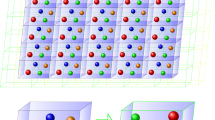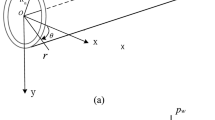Summary
The formalism of the previous paper is applied to the torsion of a right circular cylinder whose length is prevented from changing by applying a force at the end. The solution of the torsion problem leads to a second order non-linear differential equation which on can linearize and solve to the first two orders in a dimensionless torsion parameter.
With the values of the third order elastic constants found in the ultrasonic literature one calculates to first order the new radius, the torque and the force at the end of the cylinder for six metallic compounds and three non-metallic ones.
Similar content being viewed by others
References
Rainer, M.: Simple torsion of a circular cylinder. Israel Journal of Technology4, 187–192 (1966).
Smith, R. T., Stern, R., Stephens, R. W. B.: Third-order elastic moduli of polycrystalline metals from ultrasonic velocity measurements. J. Acoust. Soc. Am.41, 1112–1118 (1966).
Graham, L. J., Nadler, H., Chang, R.: Third-order elastic constants of single-crystal and polycrystalline Columbium. J. Appl. Phys.39, 3125–3133 (1968).
Smith, R. T.: Stress-induced anisotropy in solids — The acousto-elastic effect. Ultrasonics1, 135–147 (1963).
Yost, W. T., Breazeale, M. A.: Adiabatic third-order elastic constants of fused silica. J. Appl. Phys.44, 1919–1911 (1973).
Wertheim, G.: Memoire sur la torsion. Annales de chimie et de physique, third series50, 195–321 and 385–431 (1857).
Poynting, J. H.: On pressure perpendicular to the shear planes in finite pure shears, and on the lengthening of loaded wires when twisted. Proc. Roy. Soc. London82A, 546–559 (1919).
Poynting, J. H.: On the changes in the dimensions of steel wires when twisted, and on the pressure of distortional waves in steel. Proc. Roy. Soc. London86A, 534–561 (1912).
Bell, J.: Encyclopedia of Physics.VIa/I, (Truesdell, C., ed.), p. 721–726, New York: Springer 1978.
Foux, A.: An experimental investigation of the Poynting effect. Proceedings, International Symposium on Second-Order Effects in Elasticity, Plasticity and Fluid Mechanics, p. 228–251. New York: Pergamon Press 1964.
Sachs, A., Celikkol, B., Freed, A.: Body tensor formalism in finite deformation elasticity. Part I: Description and constitutive equation. Acta Mechanica78, 33–37 (1989).
Lodge, A. S.: Elastic liquids, pp. 327–328. New York: Academic Press 1964.
Murnaghan, F. D.: Finite deformation of an elastic solid, pp. 130–137, New York: J. Wiley 1951.
Author information
Authors and Affiliations
Additional information
With 6 Figures
Rights and permissions
About this article
Cite this article
Sachs, A., Celikkol, B. & Freed, A. Body tensor formalism in finite deformation elasticity part II: Application to the torsion of a circular cylinder. Acta Mechanica 78, 57–71 (1989). https://doi.org/10.1007/BF01174000
Received:
Issue Date:
DOI: https://doi.org/10.1007/BF01174000




